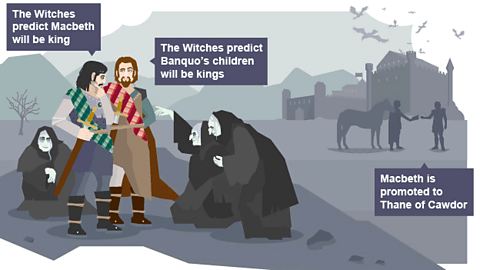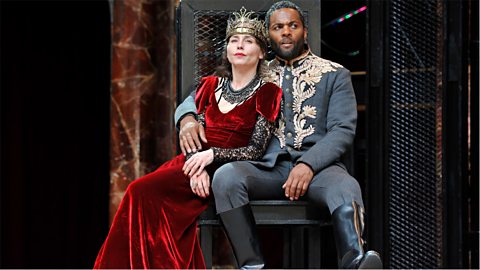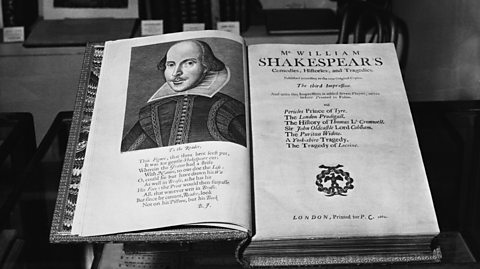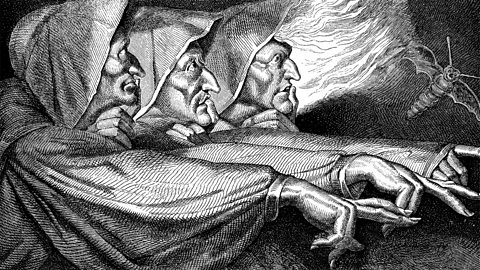Key points
Macbeth is a play by William Shakespeare that tells the story of a Scottish nobleman called Macbeth.
The play follows the story of Macbeth, its tragic heroA character who has good traits but also a weakness that leads to their downfall. , as he becomes increasingly powerful and turns to murder to get what he wants.
In the beginning, Macbeth is manipulated by his wife, Lady Macbeth, who encourages his ambition and violence.
Although Macbeth succeeds in becoming king, he quickly loses support and is killed by Macduff.
Did you know?
The character Macbeth is based on a real king from Scottish history, Mac Bethad mac FindlûÀich.
Shakespeare made lots of changes to the facts to make the play more dramatic.
How does Shakespeareãs play differ from history?
The real-life Macbeth fought and killed Duncan on the battlefield. In the play, however, Macbeth murders Duncan while he is sleeping.
Plot summary
Macbethãs key moments
Click through the slideshow to see Macbethãs key moments

Image caption, Macbeth and Banquo meet the Witches
Three witches predict great things for Macbeth.
Image caption, Macbeth tells Lady Macbeth about the Witchesã prophecies
Lady Macbeth persuades Macbeth to kill King Duncan to take the throne.
Image caption, Macbeth kills King Duncan
Macbeth kills King Duncan and becomes King of Scotland.
Image caption, Macbeth has Banquo murdered
Macbeth remembers what the Witches said about Banquoãs sons becoming kings of Scotland. Macbeth sends assassins to murder Banquo and his son, but his son, Fleance, escapes. Later that evening, Macbeth is haunted by the ghost of Banquo.
Image caption, Macbeth starts to believe he is invincible
Macbeth goes to see the Witches again. They tell him that no one ãof woman bornã can harm him and he thinks that he is invincible.
Image caption, The death of Macbeth
Macbeth puts on his armour, thinking that he is invincible. But Macduff, who was born by caesarean section, is able to kill Macbeth and chops his head off. The Witches have tricked him.
1 of 6
Macbethãs personality
Macbeth is a complicated character, who shows a range of personalities at different points in the play.
Ambitious
Macbeth is determined to become king, and Lady Macbeth uses this to control him. Macbeth becomes increasingly violent to try and fulfil his ambition.
Superstitious
Macbeth believes the Witches when he first meets them and returns to meet them for more predictions later in the play.
Guilty
Following the murder of Duncan, Macbeth is consumed with guilt and is surrounded by death and violence.
Violent
Macbeth is a violent character who becomes trapped in a cycle of bloodshed and conflict.
Brave
At the start of the play Shakespeare shows Macbeth as a brave and loyal soldier. He is rewarded for his bravery with the title ãThane of Cawdorã At the end of the play, Macbeth decides to fight even though he knows that he will likely die.
Changes in character
Which of these statements is true?
Macbeth is controlled and manipulated by Lady Macbeth.
Macbeth has to persuade Lady Macbeth to murder King Duncan.
Macbeth shows no guilt immediately after murdering King Duncan.
Statement 1 is true - Macbeth is controlled and manipulated by Lady Macbeth. When Lady Macbeth receives Macbethãs news in a letter, she plans to make the most of the situation. Macbeth and his wife plan Duncanãs murder together. When Macbeth hesitates, his wife encourages him. She also plants the murder weapons on the guards to frame them.
Relationships
Lady Macbeth
At the start of the play, Macbeth trusts his wife and they have a close relationship. Lady Macbeth controls and dominates Macbeth. However, Macbeth then goes on to commit more violence without his wifeãs influence. Becoming king and queen does not bring them happiness and they are eventually driven apart.
A timeline of Macbeth and Lady Macbethãs relationship:
Banquo
The play begins with Macbeth and Banquo as friends. However, as the play develops, Banquo starts to suspect that Macbeth has killed King Duncan. Macbeth believes that Banquoãs son, Fleance, threatens his position as king. Macbeth has Banquo murdered and tries to murder Fleance, who escapes.
Macduff
Macduff is loyal to King Duncan and he follows Malcolm to England to support his fight against Macbeth. When he learns of the murders of his wife and family, Macduff feels guilty about leaving them and driven by a need for revenge. At the end of the play he kills Macbeth and Malcolm is declared the new King of Scotland.
The Witches
Initially the Witches appear to help Macbeth, however, they actually contribute to his downfall. They trick Macbeth and encourage his violent actions.

This image is taken from a 2016 production of Macbeth starring Tara Fitzgerald as Lady Macbeth and Ray Fearon as Macbeth. What does it show the audience about the relationship between Macbeth and Lady Macbeth?
This image shows that Lady Macbeth and Macbeth have a close relationship, at least at this point in the play. Macbeth has his arm around his wife and Lady Macbeth looks relaxed and confident. Lady Macbeth is wearing her husbandãs crown which suggests that, although he is the king, Lady Macbeth has power because she is able to manipulate her husband.
Activity - Order it
What do these key quotations mean?
For brave Macbeth ã well he deserves that name ãÎ
Soldier
Act 1, scene 2
Macbeth is a brave fighter who is admired by others and loyal to King Duncan. This makes his downfall more tragic. He changes from a good man into an evil murderer.
Will all great Neptuneãs ocean wash this blood
Clean from my hand?
Macbeth
Act 2, scene 3
Macbeth is upset after the murder of King Duncan. The blood on his hands represents his guilt. He feels that no amount of water can wash away his guilt.
O, full of scorpions is my mind, dear wife!
Macbeth
Act 3, scene 2
After he becomes king, Macbeth is still fearful. He is desperate to hold onto power and is also tortured by what he has done. The scorpions represent his emotional pain and suffering.
Dead butcher
Malcolm
Act 5, scene 7
At the very end of the play, the new king, Malcolm, calls Macbeth a ãbutcherã to suggest that he is an evil murderer who kills without regret.
Test your knowledge
Play Bitesize secondary games. gamePlay Bitesize secondary games
Have fun playing science, maths, history, geography and language games.

More on Macbeth
Find out more by working through a topic
- count4 of 6

- count5 of 6

- count6 of 6

- count1 of 6
